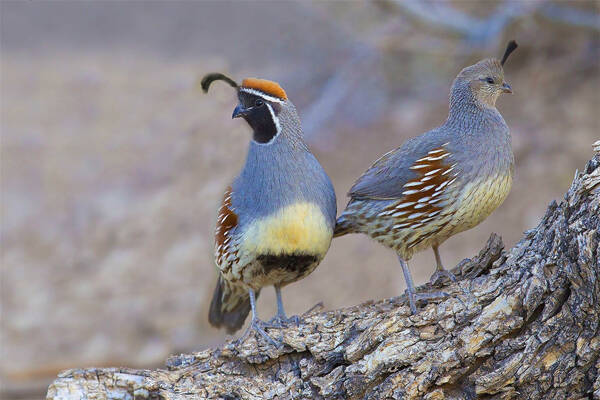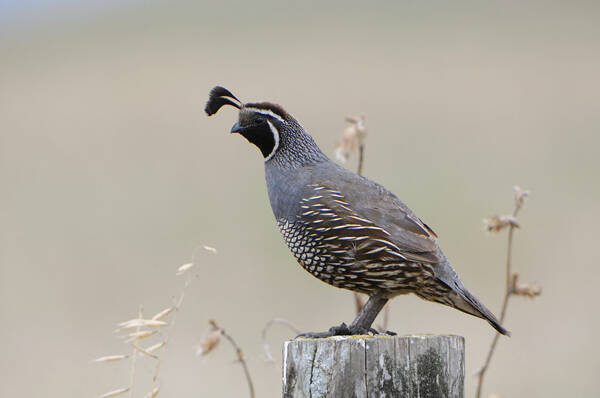Gambel's Quail
IUCN
LCBasic Information
Scientific classification
- name:Gambel's Quail
- Scientific Name:Gambel's Quail,Callipepla gambelii
- Outline:Landfowl
- Family:Gallinorhynchia Ornithidae Ornithidae
Vital signs
- length:26-28cm
- Weight:160-200g
- lifetime:3-5years
Feature
There is a black curved crown feather on the forehead, similar to the beaded quail
Distribution and Habitat
It is found in Mexico and the United States. It is a special species endemic to the southwestern tip of North America. The distribution is small and dense, concentrated in Arizona, USA. Extreme southern California, Nevada, Utah, eastern Colorado, and Texas. It also occurs in northern Mexico, along the Rio Grande River and along the northern Pacific coast.
It lives in temperate forests, forest margins, grasslands and farmlands in and around the Sorora Desert of North America. It does not migrate long distances, preferring to inhabit vast, sparse grasslands and shrubs. Frequent spiny thicket in the deserts of southwest North America. Usually closely associated with mesquite, although this shrub is not absolutely necessary for their survival. Close to water sources (springs, river valleys, drainage areas), these slightly inhospitable landscapes are sought after. This area must also provide some form of vegetation for two main reasons: quail absolutely need a fairly dense canopy to hide
Appearance
The black-bellied quail is 26-28 cm long, has a wingspan of 42 cm, and weighs 160-200 grams. There are seven subspecies, which vary slightly from individual to individual. The feathers are colorful, the shape is healthy, the beak is short and strong, and the wings are short and round, suitable for short distance flight and rapid take-off. They have strong feet, short wings, and prominent body feathers, with feathers on the top of the male bird's head. Upper body, neck, front chest blue, shiny. The wings are reddish-brown with white stripes. The female is pale and lacks plumage. The feet have three toes in front and big toes in back, almost forming a plane, which is conducive to walking. The sternum is well developed with strong muscles.
Details
Callipepla gambelii belongs to the family Callipepla, there are 7 subspecies, and the distribution area is slightly different.

Black-bellied quails are usually active in the morning and late afternoon. 90% of our food comes from plants. A variety of seeds and leaves are ingested throughout the year. Flowering plants, grasses, shrubs and shoots, cactus fruits and berries make up most of its menu at certain times of the year. Small amounts of insects are also eaten to supplement the diet during the spring and early summer breeding seasons. The main food is seeds, berries, and sometimes leaves, roots, and insects. Foraging is usually done by digging your toes and then using your beak. There are usually two adult birds and a variable number of subadult birds in small groups of up to 16 birds, with their own specific areas of activity.
Communication between the different members of the quail is carried out by calling. During the hottest part of the day, the birds will hide in some shady places, but if the environment and climate are cold, they will also appear in warm places, and the birds can stay active for a longer period of time when the weather is warm. The water requirement is not very important. Since black-bellies do not like to expose themselves, they are only present at water points when necessary.

The breeding season begins in March. At the beginning of the pair, the male will offer the female food inducements. Research shows that this is the most common and successful form. In monogamy, the female chooses the nest site, and the male and female birds build nests and raise young together. The nest is spherical, about 4 cm deep, 30 to 60 cm in circumference, relatively rough, hidden in dense vegetation, often nested nests, sometimes built between the branches of trees, 2 to 10 meters above the ground. Covered with grass and feathers. The female birds shed a lot of feathers on the abdomen during brooding, forming brooding spots. In the spring, the female lays 10 to 12 eggs, which are white, smooth, and often brown spotted. Male and female birds take turns incubating for 22 or 23 days. When the bird is born, it lives with its parents for the first summer.
Listed on the International Union for Conservation of Nature (IUCN) 2016 Red List of Threatened Species ver 3.1 - Not Threatened (LC).
Protect wild animals and eliminate wild meat.
Maintaining ecological balance is everyone's responsibility!








